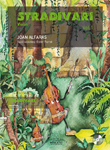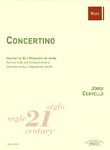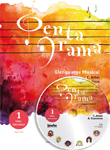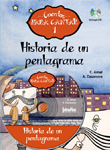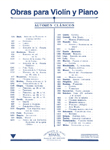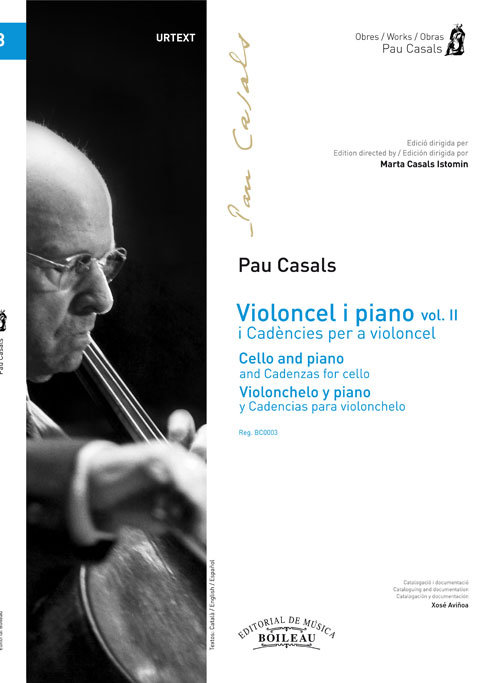Violoncel i piano, vol. 2
Incluye cadencias para violonchelo
Violonchelo y Piano
CASALS, Pau; CASALS, PabloReg.: BC0003
22,50 €
P.V.P. (VAT included 4%)
Add to cart
- Review: CASALS ISTOMIN, Marta
- Ensemble: Duos: With piano.
- Genres: Classical / contemporary: Chamber.
- Language of the comment: Català/English/Castellano
- Product format: Partitura + particellas
- Difficulty level: Intermediate-advanced
- Period: 1st half S. XX
- Publishing house: Editorial Boileau
- Collection: Pau Casals
- No. of pages: 68+20
- Measure: 31,00 x 23,00 cm
- Lenght: 22'00"
- ISBN: 978-84-8020-904-5
- ISMN: 979-0-3503-0849-9
- Available in digital: No
- Available for rent: No
This second volume of works for cello contains three very different sections: On the one hand, three pieces composed for cello accompanied by the piano with an inconsistent range would be the continuation of the pieces contained in the first volume of works for cello accompanied by the piano. Secondly, a piece for singing and piano with the occasional appearance of the cello is the only one that takes on this format, and although it will also appear in the book of works for voice and accompaniment, it has a space here devoted to the cello. Thirdly, cadences from classical works that Casals used in some of his concerts are presented here. The interest in these short pieces lies in the knowledge of the way that the cellist treated the sound material of the works that he had to perform and at the same time, are very useful for performers who wish to make use of them.
II.E-7a.-El cant dels ocells (Song of the birds)
The musical theme of El cant dels ocells is from a popular piece, probably from El Vendrell area where it was a very well known song. It is characterised by the minor key, the initial ascent of the melody, the return to a passing note and the change of key to major in the chorus. Its literary theme had Christmas-time reminiscences that are closely linked to the naturalistic and forest-inspired contents of the nineteenth-century romantic era that Àngel Guimerà, an author with close links to El Vendrell, included in one of his theatre plays entitled Titaina (1910), which Enric Morera put the music to. In the version that Pau Casals made of this piece, he included an introduction to the popular melody and turned it into a harmonic structure that lends a different nature to the original Christmas melody, almost turning it into a hymn. It has been one of Casals most published works around the world to the extent that he has been mistakenly believed to have composed the song. Casals made a re-creation of the song, made it popular with the cello and composed several instrumentations and arrangements of it. Here is the version for cello accompanied by the piano, which evokes the work of the orchestra through the string resources, such as the trémolos and the wide range of chords on the fingerboard.
I.Ca-7.-Poème
Piece dedicated to Frasquita Vidal, a woman of great musical sensibility who took charge of Pau Casal’s management affairs throughout her life (she died in 1954), allowing the cellist and conductor to focus fully on his art. There are three sources of this piece: a manuscript comprising 6 pages that only bears the note “To Frasquita Vidal from Capdevila” and signed “San Salvador Nov. 1917”; a second manuscript by a copyist with no signature of just over 6 pages and a third within a document of sketches that only contains the cello part of the work. It is a score that begins in the B flat Major key and 3/4 time, whose central section modulates to C sharp Major. It is a work with variations of movement that after a “Lento” beginning, passes through an “Animato moderato”, Animato ma non troppo”, “Lento” and then “Molto lento.
I.Ca-6.-Morceau de concours
There is a holographic handwritten score of the beginning of the piece that is full of corrections and a full published score, which he composed for the Conservatory of Paris, as the title suggests. It is written in C sharp minor and 3/4 time with a detailed cello work and accompaniment that combines virtuosity and thematic
elegance. In it is a repertoire of rhythmic resources, of scales and developments of the melody that demonstrate the composer’s desire to display his command of the instrument. It has a pencil-written note reading “Morceau de concert” and is dated 1907.
II.B-6.-La balada dels dos estels (The ballad of the two stars)
A mid-duration piece comprising 12 handwritten pages for voice, cello and piano in the F sharp minor key and 6/8 time and occasionally 2/4 and 9/8 time. It is composed for a text by Ventura Gassol (1893-1980), a poet and politician, who was Minister of Culture of the Regional Government of Catalonia during the Second Spanish Republic and who, like Casals, was exiled and never stopped fighting to defend artistic values and politicians like himself. The piece starts with a brief introduction with the piano based on arpeggiated chords on the main key and a modulation to D minor and B Major, which introduces the cello, making some designs on the main notes in the key and showing the way for the voice, which enters in bar 28. At that point, the cello stops and the piece is led by the voice and the piano accompaniment. The singing part is lyrical and moves through the A Minor key, with occasional forays into other keys that, as is common of Casals, lend colour to the work. A second section of the voice in quasi alegretto soars over C sharp minor and takes on a more brilliant nature. At the end of the singing part, which forms a da capo, the singing ceases, the piece goes back to F sharp minor and the cello takes the lead part again. The piece is enriched with indications of movement such as “Calm”, “Moderate”, etc. It is signed “Prades, September 1942”.
The cadences
Pau Casals’ work as a concert artist is well known. He is better known for his social relevance than as a composer, a task that was always intimate to him with no clear desire to produce the usual repertoire. From the moment he began his career as a cello soloist, he started to earn a prominent place on the international soloist panorama thanks to the quality of his performances. This brought him prestige, skill and an endless list of friends amongst top musicians and conductors that testified to his musical and humanistic qualities.
There are three features that may distinguish Casals’ performances for the main concertos for cello and orchestra from the great repertoire with respect to other contemporary soloists. Firstly, there is the choice of works, which created models for his contemporaries and followers. The works that Casals introduced into his repertoire seduced musicians and the public alike, and they became works common in concerts. Secondly, there is his way of interpreting the violoncellist’s part, which increased his prestige as the great soloist that he developed throughout his life. Thirdly, there are the cadences for the concerto movements that required them.
The cadence is the final part of a concerto movement in which, after the theme has been presented and the orchestra has prepared us with a short silence, the soloist boldly takes on the role of summing up the theme in a few bars. They normally do so with a skilful combination of respect for the composer’s material and the themes provided, and above all virtuoso moments of the musician. Thus, these cadences become decisive moments in the movement and are a measure of the musician’s quality and of the soloist as a creator. The cadence therefore has the task of summing up the movement’s sound content, and when classical concertos are over they are linked to the end of the movement. It was not unusual for some of the great musicians such as Brahms or Anton Rubinstein to write the best polished cadences for the concerts they conducted.
Pau Casals left a very distinguished collection of cadences, some of them in the form of written scores and others in the form of recorded discography. They are published in this volume for the interest they have always aroused to be used by cellists who usually use them in their performances.
II.E-1.-Cadenza I (n.d.) I. Movement of the Concerto for cello and orchestra in A major by Carl Ph. E. Bach.
II.E-2.-Cadenza II (n.d.) "Finale" of the III. Movement of the Concerto for cello and orchestra in A major by Carl Ph. E. Bach.
II.E-3.-Cadenza III (n.d.) III. Movement from the Concerto for cello and orchestra in B flat major by Luigi Boccherini.
II.E-4.-Cadenza IV (n.d.) I. Movement from Concerto for cello and orchestra in D major by Joseph Haydn.
II.E-5.-Cadenza V (n.d.) II. Movement of the Concerto for cello and orchestra in D Major by Joseph Haydn.
II.E-6.- Cadenza VI (n.d.) Concerto for cello and orchestra in A minor by Robert Schumann.
El cant dels ocells (3'00")
Poème (8'00")
Morceau de concours (1'20")
La balada dels dos estels (9'25")
Cadències:
Cadenza I
Cadenza II
Cadenza III
Cadenza IV
Cadenza V
Cadenza VI

